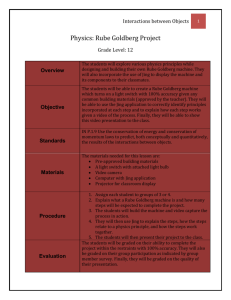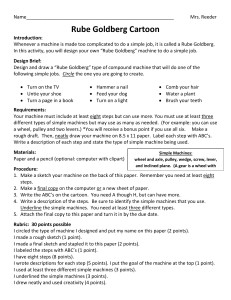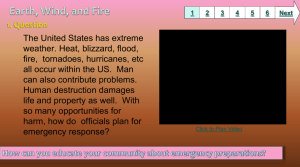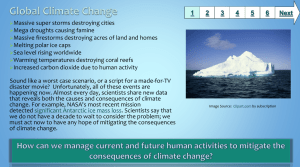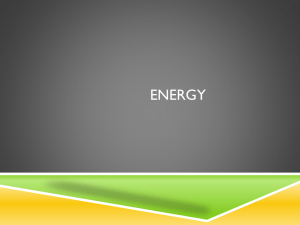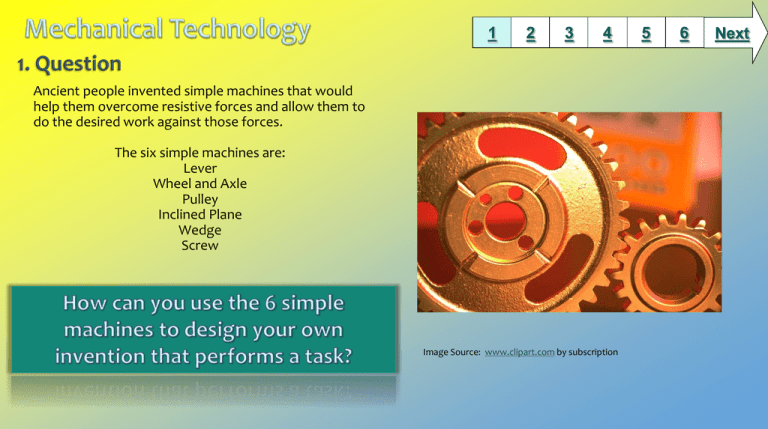
1
2
3
4
Ancient people invented simple machines that would
help them overcome resistive forces and allow them to
do the desired work against those forces.
The six simple machines are:
Lever
Wheel and Axle
Pulley
Inclined Plane
Wedge
Screw
Image Source: www.clipart.com by subscription
5
6
Next
1
2
3
4
5
6
Next
You will use the online sources below to gather information about
the 6 simple machines.
Essence of Simple Machines
World Book Video
Science in Context
BrainPOP Movies (See the library media specialist for log in
information, if requested.)
Student activity listed on next slide.
Image Source: www.clipart.com by subscription
1
2
3
4
5
6
Next
You will use the online sources together
information about the six simple
machines and how they are used to
provide a mechanical advantage. Use this
Simple Machine Chart to record your
research notes; remember to cite your
sources on the organizer.
Image Source: www.clipart.com by subscription
1
Can you design a “Rube Goldberg” machine? A
famous cartoonist named Rube Goldberg made
cartoons of long, tedious inventions that used many
steps to do a simple task. These inventions included
many simple machines. Here is an example or this
one!
Make a drawing of your design, or use digital drawing
tool like Dabbleboard.
Use the six simple machines, and label each.
3
4
5
6
Next
Use the Web 2.0 tool Dabbleboard as a digital
drawing tool.
Not sure how? Use this tutorial for help.
Choose a task. The purpose of a Rube Goldberg
machine is to seriously over-engineer a process in
order to perform a simple task. Examples- popping a
balloon, or ringing a bell
2
Checklist for Your Goldberg Machine
Detailed & completely labeled project, all
steps are labeled & explained, all six simple
machines are labeled. Neat, & Legible
Simple machines are used correctly to
perform the correct task.
This scoring tool will be used to grade your
writing.
Describe how your invention would work by writing
about each step, and what materials you would use.
1
2
3
4
5
6
Next
Extra Practice!
Simple Machines in Use
Goldburger to Go- a Goldberg machine that needs
a few minor adjustments before it can work
correctly.
Tom and Jerry- build your own Goldberg like
machine to help Tom catch Jerry!
Rube Goldberg’s Official Website
More information about simple machinesCanada Science and Technology Museum
News stories on simple machinese! Science News
1
BCPS Curriculum
Students will classify the attributes of engineering design.
Describe the engineering design process as a systematic, iterative approach to
problem solving that yields design solutions.
Describe the personal characteristics involved in engineering, including creativity,
resourcefulness, and the ability to visualize and think abstractly.
Define constraints on the engineering design process, including safety, reliability,
economic considerations, quality control, environmental concerns, manufacturability,
and ergonomics.
Maryland State Curriculum
Develop abilities to apply the design process. (ITEA, STL 11)
Apply the design process to solve problems in and beyond the classroom. (ITEA, STL 11-H)
Specify criteria and constraints for design. (ITEA, STL 11-I)
Common Core State Standards
Reading: 1. Read closely to determine what the text says explicitly and to make logical
inferences from it; cite specific textual evidence when writing or speaking to support
conclusions drawn from the text.
Writing: 7. Conduct short as well as more sustained research projects based on focused
questions, demonstrating understanding of the subject under investigation.
Standards for the 21st Century Learner
Draw conclusions, make informed decisions, apply knowledge to new situations, and create
new knowledge.
2
3
4
5
6
Time Frame:
2 class periods – one for research in computer lab and one to
create machine.
Differentiation:
Students can work independently or in group.
Provide extended time.
Print student copies to allow for highlighting important
information.
Have students use assistive tools embedded in the BCPS
databases such as read aloud and dictionary links.
Learning Styles: Visual Learners, Reflective, Tactile Learners,
Auditory Learners Verbal-Linguistic Intelligence,
Analytical Understanding
Notes to the teacher:
Students could present their machine to classmates.
View links before hand, along with Dabbleboard.
Students may print their work from Dabbleboard or choose
to use another tool.
If there are problems, see your Library Media Specialist.
Last updated: July 2015
Created by Sara Saffell linked to email address, Library Media Specialist
BCPS Slam Dunk Research Model, Copyright 2015, Baltimore County Public Schools, MD, all rights reserved. The models may be used for educational, non-profit school use only.
All other uses, transmissions, and duplications are prohibited unless permission is granted expressly. This lesson is based on Jamie McKenzie’s Slam Dunk Lesson module.

